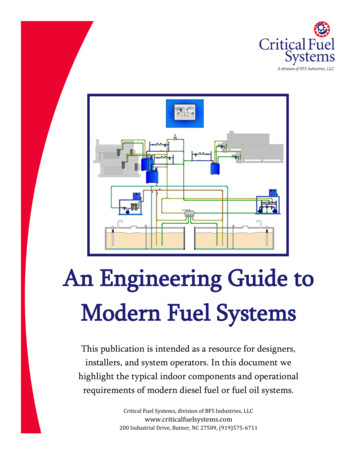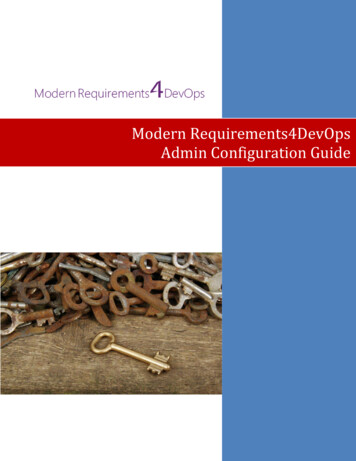
Transcription
An Engineering Guide toModern Fuel SystemsThis publication is intended as a resource for designers,installers, and system operators. In this document wehighlight the typical indoor components and operationalrequirements of modern diesel fuel or fuel oil systems.Critical Fuel Systems, division of BFS Industries, LLCwww.criticalfuelsystems.com200 Industrial Drive, Butner, NC 27509, (919)575-6711
A Guide to Modern Fuel SystemsTable of ContentsIntroduction .2Heated returns from generators .3Generator pump sizing and selection .5Boiler system pump sizing and selection .6Pump Types .8Building fuel piping and fittings .12Day tank sizing and selection .13Care and storage of diesel fuel .17Controls, monitoring and communications .20Engineering data, generator equipment sizing .22Engineering data, boiler equipment sizing .23Engineering data, routine maintenance .24Copyright 2012, Critical Fuel Systems, div of BFS Industries, LLC1
IntroductionThe focus of this guide is diesel fuel systems for emergency generators and other applications thatrequire long term storage of diesel fuel (or fuel oil). We will discuss the portion of the fuel systemthat is found in the building. Storage tanks and buried piping will not be addressed.Description of a modern diesel fuel system as a standby energy source.The modern diesel fuel or fuel oil systems are used differently than systems designed a decade ormore ago. In early fuel oil system designs, boilers were the primary user of the fuel. The fuel oilwas a primary energy source used consistently throughout the year. With the advent of natural gas,the liquid fuels were replaced throughout most of the country as a primary energy source and relegated to stand-by status.Natural gas systems in their early life were unreliable and insufficient for use throughout the entireyear. The operators of large natural gas equipment would be required, usually during cold weather,to shift from burning natural gas to burning fuel oil. Systems designed during that time were sizedwith the intent that the fuel would be turned over several times throughout the year.Today, the natural gas infrastructure is very reliable, if boilers do have a back up fuel oil system,they may operate on oil for brief periods each year, never consuming much fuel. On emergencygenerator systems, the fuel usage is typically no different. In both of these cases, the stored fuelmay sit in the storage tanks for years at a time and will require special treatment to insure reliableoperation when needed.In this guide we specifically address several issues unique to diesel fuel systems supporting emergency generators. Many of the same issues will apply to boilers where very small amounts of oil areburned each year.Diesel Fuel PropertiesBesides providing chemical energy for the boiler or generator to convert, diesel fuel serves as a lubricant for the pumps and lubrication/cooling for the injectors of engine generators. When notmaintained the fuel will degrade rapidly beyond the point of usability, especially for generator systems. The degradation process is accelerated by; moisture, heat, oxygen, and biological growth.Diesel fuel or #2 fuel oil is hydrophilic, it will attract moisture. Some of the moisture will settle outof the fuel to become free water. Removing the moisture and free water is key to maintaining thefuel.2
Heated returns from generatorsThe diesel engines that powers modern generators are built with an integral onboard fuel pump.This pump will draw fuel from the day tank or fuel supply header and deliver it to the fuel injectorsat the correct pressure. This pump moves more fuel than the generator will consume at any givenload. The unused fuel is circulated through several components as a means of cooling them undervarying loads. By design this unused fuel absorbs heat and, in most cases, this heated fuel is returned to the day tankThe temperature differential between the generator pump inlet and return to day tank may be lessthan 15 F. Though the initial rise in day tank temperatures is modest, the effects are cumulative andunder certain load conditions the day tank temperature may approach critical levels. One consequence of the fuel heating up is that at a certain point the generator output will decline. A good ruleof thumb is a 1% decrease in output per 10 F rise in fuel temperature above 100 F. Another consideration is that most generators now employ high fuel temperature cutouts, these switches typically activate, shutting down the generator at a fuel inlet temperature of around 150 - 160 F.Since diesel fuel can have a flashpoint near 140 F, it is advisable to never let the fuel get this warm.Besides producing potentially explosive vapors, its stability can be so damaged the diesel fuel losesmost of its lubricating properties. The fuel management and monitoring systems should maintainthe fuel temperature below 130 F. Here are a few options available to designers to control dieselfuel temperatures in the system:Option A – On board fuel coolerMost large generator manufacturers provide an option to add a fuel cooler. This maybe a section in the engines radiator or a separate on-board fuel cooler with its ownfan. This is usually preferable when available.Option B – Day tank fuel replacementSpecify a day tank temperature control option. This type of system is fairly simple,monitor the tank temperature, when it reaches a predetermined point, pump most ofthe fuel back to the storage tank and refill with relatively cool fuel from the storagetank. One advantage of this approach is that every time you replenish the tank, thepumping and control system is checked for proper operation.3
Option C – External fuel coolerExternal fuel coolers are typically used in situations where the cooler was not included in the initial design. These systems offer a cost effective retrofit providedthere is enough physical space in the equipment room or adjacent outdoor area to accommodate the extra equipment. One limitation that must be accounted for withthese arrangements is the ability of the generator’s fuel pump to return the fuel. Anyhead pressure caused by piping layout or pressure drop through the cooler must bewithin the tolerances specified by the engine manufacturer.Option D – Piped return to storage tankAn option that can work only under a few specific circumstances is returning theheated fuel back to the storage tank instead of the day tank. This arrangement requires the pump set to be sized to accommodate the added flow of fuel, including thefuel not being consumed by the engine. It would also require a much larger day tankto accommodate the same run time requirements.4
Generator Pump SizingPump sizing is typically straightforward. Calculate the total generator load, convert KWH to GPHfuel consumption then multiply by 4 to determine pump size. The factor of 4 is typical with the goalto provide a 15 minute fill cycle at full load for the pumps. This factor can be altered, especially inmulti day tank applications as long as the designer is accounting for all of the variables.The following table was developed to assist in sizing the transfer pumps for a generator fuel system.This table is not designed to replace proper engineering calculations in final system design. Thefuel consumption is based on the rule of thumb that it takes about 7 gallons of #2 diesel fuel perhour to generate 100KW electrical power in a single generator.5
Boiler Systems Pump SelectionTypical modern boilers will fire natural gas as the primary fuel, with a percentage of these using #2fuel oil as a backup fuel. A system designer should be aware of a couple of key points when involved with boiler fuel oil systems. 1) Most boilers firing fuel oil will have their own fuel oil pump.2) This pump can typically handle a low suction pressure of 15‖Hg without difficulty but a high suction pressure of over 3 psig can cause the failure of the pumps seals. This high pressure can becaused by a fuel transfer pump or the static head caused by an elevated (relative to boiler pump)supply system.Low Suction Pressure Limit – 15‖HgHigh Suction Pressure Limit – 3 psigSimplifying the fuel system , reducing capital and operational costs is simple, the fuel systems formodern boilers have evolved in a way that more than 80% of new boilers that burn fuel oil are provided with their own on-board fuel oil pumps. If the onboard pumps have the ability to pump directly from the single storage tank this may be a very practical and efficient arrangement. In mostsystems this is not typical and a transfer pump is needed to pump oil out of the storage tank(s) anddeliver to the boiler mounted pumps at a very low pressure. This transfer pump must be over sizedby a factor of 1.5-2 to accommodate the extra flow required by the onboard pumps. Always checkthe flow of the fuel pump supplied by the manufacturer. On some boilers there can be a 5 to 10times factor for the pump size compared with the burn rate. A simple solution is to do away withthe boiler’s onboard pumps and increase the supply pressure from the transfer pumps.This arrangement will eliminate the cost and electrical load of the boiler mounted pumps, reduce theelectrical load of the transfer pump as well as reduce the required pipe sizing. The only cost addermay be a pressure regulator on the fuel supply pipe to each boiler. This cost is usuallyoffset by the elimination of the burner pumpand removes the single point of failure thatthe burner mounted pump introduces. Thistable was developed to assist in sizing thetransfer pumps for a boiler fuel oil system.This table is not designed to replace properengineering calculations in final system design. The fuel consumption is based on atypical firetube boiler firing 140,000btu/g #2fuel oil.6
Boiler Systems Pump SelectionThis arrangement will work fine,in most cases, as long as the pumpsuction does not exceed 15‖Hg.This arrangement is not recommended for multiple storage tanks.When the suction pressure is toomuch for the boiler mounted pumpsor when multiple storage tanks arerequired this has been the traditionalarrangement.By eliminating the boiler mountedpumps the overall electrical load andequipment cost can be reduced.7
Pump TypesSuction pumps or pressure (submersible) pumps? Choosing between a submersible pump and asuction type pump set is fairly easy. A suction type pump set is almost always the best choice whenaccounting for ease of operation and maintenance. The primary point when considering locating asuction pump set is the location relative to the vertical distance between the bottom of the storagetank to the actual pump suction. If this lift (plus the pressure drop through piping, valves and fittings) exceeds the 15‖Hg capacity of a suction pump then the design engineer has no other optionthan to specify a submersible pump. Other key points of consideration in the installation of a suction pump are the availability of space and facility lay-out.After the designer has determined the required pumping capacity the next choice to make is thepump type. The design engineer has the choice of two different general types of pumps to transferfuel from the storage tank to the day tanks or piping systems. The two types are; 1) suction systems,built with positive displacement pump sets, or 2) pressure pump systems which are submersiblepumps installed in the diesel fuel storage tanks.If the system is going to have any underground piping note that the EPA has requirements for leaktesting of buried piping. Pressurized piping systems have a much more stringent requirement fortesting than suction type systems. In fact, if the suction type system piping; 1) is installed withenough slope back to the storage tank to complete drainage after the pump shuts off, and 2) the onlycheck valve installed is installed close to the pump, then no leak detection system is required for thepiping. All other systems are required to employ monitoring systems and line tightness testing on aperiodic basis.The following drawings show the suction and pressure pump sets in multiple tank applications withfull redundancy. In order to have redundant pumping ability with each storage tank a pressure pumpsystem requires 2 pumps in each storage tank. Notice in both drawings that the supply and returnsare piped into a common tank selection valve.8
Pressure Pumps are completely submerged in thefuel with the pump inlet at a minimum of 6‖ fromthe bottom of the tank. Full redundancy requires theuse of 2 pumps in each tank. Typically, each pumpwill require a separate piping sump when the tanksare buried. This is to allow clearance to install andremove the pump.Suction Type Pump sets may be constructedusing multiple pump arrangements. The typical pump set is a duplex type which should bespecified to mean two pumps, each sized tomeet the entire system flow requirements withthe other being fully redundant.Suction Pump Construction. Pump seals should be mechanical, self adjusting seals thatpermit no leakage unde
Diesel fuel or #2 fuel oil is hydrophilic, it will attract moisture. Some of the moisture will settle out of the fuel to become free water. Removing the moisture and free water is key to maintaining the fuel. 3 Heated returns from generators The diesel engines that powers modern generators are built with an integral onboard fuel pump. This pump will draw fuel from the day tank or fuel supply .File Size: 2MBPage Count: 28People also search forN P Fuelnew diesel fuel requirementsoil piping systemsModern Heating Co LLChow to decommision process pipelinegasoline and diesel fuel update











